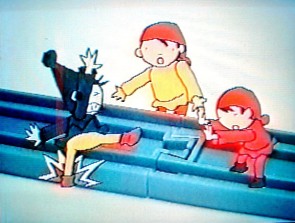Several factors around the enclosures Super. Firstly before the rise of PLA the main material in use was ABS. While ABS is generally stronger when printed correctly it suffers from several problems, the level of detail is not as good as PLA, it needs much higher bed/nozzle temperatures to work properly, it also suffers from 'warping' if it cools too quickly as well as delamination of the layers. Having the printer enclosed you can control the temperature more accurately and allow the model as well as individual layers to cool more slowly thus reducing the chance of warping and layer seperation.
With the growth in popularity of PLA the need for an enclosure have pretty much disappeared, the filament melts at a lower temperature and it does not suffer from shrinkage, so you don't have to worry about drafts or temperature fluctuations as much. It also has the added advantage that you can produce the printers at a lower cost as there is no overhead of the cabinet/fans etc...
Having said that one popular practice for people with printers such as the Ender 3 or other similar Prusa based designs is to buy a couple of 'Lack' tables from Ikea, mount one on top of the other and enclose the part between the two printer tops with perspex sheeting or similar, this allows people to effectively build an enclosure very cheaply relatively speaking and make the printing of ABS if you need its good properties much easier than in an open printer. I mean you can print ABS on an open frame model as I've done it, you just have to be very careful with the positioning of the printer to avoid drafts, turn off the cooling fans etc... and run at much higher temperatures which can themselves cause issues unless you upgrade to an all metal hot end...
Phew, and I was trying to make that easy lol!
Should have just put "you don't need an enclosure unless you print a lot of ABS material"



![[-]](https://www.blueplastictracks.org/images/collapse.png)

![[Image: IMG-20190129-221826700.jpg]](https://i.postimg.cc/zvJN0Dwz/IMG-20190129-221826700.jpg)
![[Image: IMG-20190130-011935642.jpg]](https://i.postimg.cc/DwrY29ts/IMG-20190130-011935642.jpg)
![[Image: IMG-20190130-012025529.jpg]](https://i.postimg.cc/YC7Bfz76/IMG-20190130-012025529.jpg)
![[Image: IMG-20190201-084630041.jpg]](https://i.postimg.cc/VN9TSCh7/IMG-20190201-084630041.jpg)
![[Image: IMG-20190201-084645732.jpg]](https://i.postimg.cc/qRkF27Vp/IMG-20190201-084645732.jpg)
![[Image: IMG-20190201-084704859.jpg]](https://i.postimg.cc/SKb3Nrg2/IMG-20190201-084704859.jpg)
![[Image: IMG-20190201-084715803.jpg]](https://i.postimg.cc/gk511dRK/IMG-20190201-084715803.jpg)
![[Image: IMG-20190201-084727635.jpg]](https://i.postimg.cc/g2Z1W5Hb/IMG-20190201-084727635.jpg)
